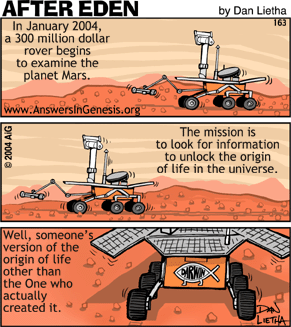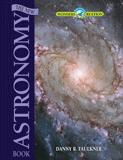
Chapter 22
Did Life Come from Outer Space?
The simple answer is NO! The Bible states that God created all living things on earth by His spoken word on Days Three, Five, and Six of the creation week. However, the concept that life originated in outer space and was then transferred to earth is popular in today’s society. Some believe that bacteria (considered “primitive” life) or organic molecules necessary for life came from other planets, meteors, or comets. Some even suggest that intelligent extraterrestrial aliens sent life to earth. Many people are eager to believe in any ideas concerning the origin of life as long as they exclude the Creator God and the truth of His Word.
Why Life from Outer Space?
Why do scientists want to push the origin of life into outer space rather than believe that life originated on earth? The answer: complexity and time.
Complexity
Life on earth is very complex. Bacteria are considered to be the simplest life form. However, several examples from the bacterial world make it clear that the word “simple” is a relative term. Some of the “simplest” are endosymbionts—organisms that live entirely within other organisms. Candidatus Carsonella rudii, a bacterium that lives within the cells of the psyllid insect Pachypsylla venusta, is considered to have the smallest genome of any endosymbiotic bacteria.1 It has 159,662 base pairs (DNA), which encode approximately 182 genes. The genes encode proteins for amino acid (components of protein) biosynthesis, which the host insect cannot get from its diet. The host insect provides necessary proteins that are not encoded by the bacterial genome.
Nanoarchaeum equitans, an archaeal (single-celled microorganism similar to bacteria) symbiont of the archaea Ignicoccus, has 490,885 base pairs, which encode approximately 552 genes. Although many of the gene functions are currently unknown, the authors of the paper that sequenced the genome stated that “the complexity of its information processing systems and the simplicity of its metabolic apparatus suggests an unanticipated world of organisms to be discovered” (emphasis mine).2
Mycoplasma genitalium has 580,076 base pairs, which encode approximately 521 genes.3 Because of its small genome size, M. genitalium was the bacteria of choice for determination of the minimal genome (or minimum number of genes) needed to sustain life. However, determination of the minimal genome has been hampered by the finding that many bacterial genomes encode backup or alternative pathways, which are used when the main pathway is removed. Scientists have stated that this may lead up to a 45 percent underestimation of the minimal genes needed to sustain life.4 As can be seen from these examples, life in even its “simplest” forms is very complex!
Time
According to secular timelines, the earth is 4.5 billion years old. Other parts of outer space are much older (up to 15 billion years old according to big bang models). Since evolution works by random chance and even the simplest bacteria isn’t very simple, a lot of time would be required for life to evolve. Many secular scientists suggest the earth is simply not old enough to allow for the evolution of living organisms. Thus, many scientists push the origin of life into outer space to gain the time needed for life to evolve.
Does Life Exist in Outer Space?
If life came to earth from outer space, then many scientists suggest that we should be able to find evidence for living things on nearby planets, meteors, and comets. Although billions of dollars have been spent in the search for extraterrestrial life, none has been found.
Mars

Several unmanned exploration probes, rovers, and landers have been sent to Mars to determine if our closest rocky neighbor supports life or may have harbored it in the past. NASA’s Phoenix lander identified water in a sample of martian soil.5 Another NASA space probe identified specific minerals that suggested liquid water had been present on the martian surface for a longer period of time then previously estimated.6 Scott Murchie of Johns Hopkins University stated, “This is an exciting discovery because it extends the time range for liquid water on Mars, and the places where it might have supported life.”7 Although water is certainly needed for life to exist, water alone does not result in life.
Other components of martian rocks and soil make the likelihood of finding life very unlikely. NASA’s Opportunity rover produced evidence that rocks had once been in an environment that was very salty and acidic.8 Dr. Andrew Knoll, biologist at Harvard University, stated, “It was really salty—in fact, it was salty enough that only a handful of known terrestrial organisms would have a ghost of a chance of surviving there when conditions were at their best.”9
Methane, a gas associated with biological activity (think belching cows!), has been found in the martian atmosphere. Colin Pillinger, planetary scientist at the Open University (UK), stated, “The most obvious source of methane is organisms. So if you find methane in an atmosphere, you can suspect there is life. It’s not proof, but it makes it worth a much closer look.”10 However, Nick Pope, formerly associated with the British Government’s UFO project at the Ministry of Defense, thinks methane is proof, calling this discovery “the most important discovery of all time,” and saying further, “We’ve really only scratched the surface—it’s an absolute certainty that there is life out there and we are not alone.”11
The biological source of methane is believed to be bacteria living deep underground. However, it could also be due to volcanism or an unknown geological process on Mars since “plumes” of methane were identified in 2003 and the distribution of methane was found to be patchy.12 If the methane is of geological origin then it would actually make the martian surface very inhospitable for life.13
Moons of Jovian Planets
Several moons of Jupiter and Saturn, including Europa, Titan, and Enceladus, are thought to be possible sources of extraterrestrial life. All are thought to have interior oceans that might harbor bacterial life. Plumes containing water vapor erupting from Enceladus have been shown to contain organic molecules such as methane, formaldehyde, ethanol, and other hydrocarbons.14
Europa’s underground oceans are predicted to be violent.15 The waves generated in these oceans are postulated to provide an energy source necessary for life. Robert Tyler, an oceanographer at the University of Washington, stated, “The big thing is to have liquid water—and to the extent that this new paper [on violent oceans in Europa] adds an energy source, all the better for life’s prospects.”16 But water plus organic molecules plus energy does not equal life. Life requires information (DNA), and information requires an intelligent source (God).
Comets
Scientists have made calculations (based on cosmological time frames of billions of years) that in the past, comets had liquid water interiors.17 NASA’s Stardust spacecraft collected samples from the dust of comet Wild 2 and found the amino acid glycine (the simplest of all amino acids).18 Carl Pilcher, director of the NASA Astrobiology Institute, stated, “The discovery of glycine in a comet supports the idea that the fundamental building blocks are prevalent in space, and strengthens the argument that life in the universe may be common rather than rare.”19 This seems to be an overstatement since only 1 amino acid of the 20 required for life was found and other components for life such as DNA, fats, and sugars have not been found. Again, the formula of water plus amino acids (or other organic molecules) does not equal life.
Life has not yet been found in outer space and it is unlikely to exist because conditions appear too hostile for even the hardiest forms of life to exist. Even if the ingredients necessary for life (organic molecules like amino acids) were transported to earth and added to water and an energy source, life would not miraculously emerge. Life only comes from life, and life only from the Life-Giver.
If Life Did Exist in Outer Space, Could It Have Been Transferred to Earth?
Panspermia is the common name given to the concept that life originated in outer space and then migrated or was transported to earth. Panspermia is not a new idea. Lord Kelvin in 1871 suggested that life came to earth on meteors. Svante Arrhenius coined the term in 1908 and is considered the father of panspermia. We will look at the three categories mentioned in the previous section and determine if transfer of life from these sources to earth is plausible.
Mars
Several meteors of suspected martian origin have been discovered on earth. It is estimated that 5–10 percent of martian ejecta (derived from impacts by comets or asteroids) would reach earth in 100 million years (with the minimum amount of time being seven months).20 Small ejecta (> 1 cm) could arrive on earth as meteorites with a burnt outer area but an inner cool area where bacteria could presumably survive.21 But of the known martian meteorites, M.J. Burchell of the Centre for Astrophysics and Planetary Sciences at the University of Kent (UK), says that “given their size and transfer times (estimated from exposure to radiation in space), all will have received a sterilizing radiation dose during their transit to earth.”22
Moons of Jovian Planets
Impacts of these moons by comets or asteroids are also thought to generate ejecta that could then travel to other locations (but not directly to earth).23 The ejecta are postulated to travel farther into space and possibly be transferred to comets or asteroids.24 The bacteria would presumably survive in the icy interior of the comets/asteroids.25 The comets/asteroids could then travel to earth and so indirectly bring life from the Jovian moons.
Comets
During their travel close to a planet, comets could leave behind dust grains that would fall into planetary atmospheres.26 If life existed in the dust grains and could survive travel through the atmosphere, then presumably a comet could transfer life to earth.
The transfer of material from Mars, Jovian moons, and comets is plausible and in some cases has been documented. However, dust and rocks are not affected by the extreme cold and radiation of outer space, whereas life would be and would probably not survive the journey to earth. Since life has not been found to exist in outer space it is doubtful life was transferred to earth from these locations.27
Could Life Have Been Brought to Earth by Intelligent Extraterrestrial Aliens?
The concept that aliens brought life to earth is called directed panspermia. The term was first coined by the co-discoverer of the structure of DNA, Francis Crick, and Leslie Orgel in 1973.28 They postulated that since earth is relatively young compared to the rest of the universe that it was conceivable that a technologically advanced society in outer space developed even before earth existed (since it only took 4.5 billions years for a technological society to form on earth). Crick and Orgel believe that this alien society then seeded or “infected” other parts of outer space including earth with primitive forms of life (like bacteria). In their 1973 paper they propose the spaceship payload, the mechanisms needed to protect the bacteria for their long trip to earth, and possible motivations by the alien society for seeding life in outer space.
When we begin with God’s Word we see that the universality of the genetic code follows naturally from a common Designer who created all living things by His Word.
One of their main evidences to support this possibility comes from the similarity of the genetic code in all living things. They stated, “The universality of the genetic code follows naturally from an ‘infective’ theory of the origins of life. Life on earth would represent a clone derived from a single extraterrestrial organism.”29 The universality of the genetic code only follows “naturally” from their theory because of their presuppositions or starting point that their ideas about the past are supreme to God’s Word concerning the history of the origin of life on earth. When we begin with God’s Word we see that the universality of the genetic code follows naturally from a common Designer who created all living things by His Word.
The concept of directed panspermia is still advocated by many scientists today. In the movie Expelled, Ben Stein asked Richard Dawkins, a very prominent evolutionary biologist, the question, “What do you think is the possibility that . . . intelligent design might turn out to be the answer to some issues in genetics or in evolution?”30
Dawkins’s reply:
Well it could come about in the following way: it could be that at some earlier time somewhere in the universe a civilization evolved by, probably by, some kind of Darwinian means to a very, very high level of technology and designed a form of life that they seeded onto perhaps this this [sic] planet. Now that is a possibility and an intriguing possibility. And I suppose it’s possible that you might find evidence for that if you look at the, at the detail . . . details of our chemistry molecular biology you might find a signature of some sort of designer.
Burchell stated, “At present, Panspermia can neither be proved nor disproved. Nevertheless, Panspermia is an intellectual idea which holds strong attraction.”31 Sadly, this is true for many who want to exclude God and the history presented in His Word in deference to their own ideas about the past—no matter how outlandish.
Could God Have Created Life on Planets Other than Earth?
Yes, but why? Remember that God spent the vast majority of the creation week preparing the earth for the crowning glory of His creation—man. Everything God created was for man’s benefit and enjoyment. Even those things which we don’t often consider, like bacteria, were created to benefit man. Bacteria can accomplish this directly through symbiotic relationships in our guts, which help us digest food, and indirectly through cycling of nutrients and chemicals in the environment.32 Man would seem to gain no benefit or enjoyment from bacteria that exist in outer space. Although we can’t rule out that some form of non-intelligent life, such as bacteria, was created on another planet, it seems unlikely knowing the purposes of living organisms and their relationship to man on earth set forth by the Creator God.
The New Answers Book 3
Do you have answers to the big questions about the Christian faith, evolution, creation, and the biblical worldview? Now you get the important information you need regarding the existence of God, global warming and climate change, cloning and stem cells, human and chimp DNA, the importance of Mount St. Helens, and more.
Read Online Buy BookFootnotes
- Atsushi Nakabachi et al., “The 160-Kilobase Genome of the Bacterial Endosymbiont Carsonella,” Science 314 no. 5797 (2006): 267.
- Elizabeth Waters et al., “The Genome of Nanoarchaeum equitans: Insights Into Early Archaeal Evolution and Derived Parasitism,” Proceedings of the National Academy of Sciences USA 100 no. 22 (2003): 12984–12988.
- USA 100 no. 22 (2003): 12984–12988. 3. JCVI Comprehensive Microbial Resource, “Mycoplasma genitalium G-37 Genome Page,” www.cmr.jcvi.org/cgi-bin/CMR/GenomePage.cgi?org=gmg.
- Csaba Pál et al., “Chance and Necessity in the Evolution of Minimal Metabolic Networks,” Nature 440 no. 7084 (2006): 667–670.
- BBC News, “Nasa’s Lander Samples Mars Water,” www.news.bbc.co.uk/2/hi/science/nature/7536123.stm.
- BBC News, “New Minerals Point to Wetter Mars,” www.news.bbc.co.uk/2/hi/science/nature/7696669.stm.
- Ibid.
- BBC News, “Early Mars ‘Too Salty’ for Life,” www.news.bbc.co.uk/2/hi/science/nature/7248062.stm.
- Ibid.
- Fox News, “Clouds of Methane May Mean Life on Mars,” www.foxnews.com/story/0,2933,479997,00.html.
- Ibid.
- Judith Burns, “Martian Methane Mystery Deepens,” BBC News, www.news.bbc.co.uk/2/hi/science/nature/8186314.stm.
- Ibid.
- Lori Stiles, “Evidence for Ocean on Enceladus: Tiny Saturn Moon Could Be Targeted in Search for Extraterrestrial Life,” PhysOrg, www.physorg.com/news167498118.html.
- Anne Minard, “Jupiter Moon Has Violent, Hidden Oceans, Study Suggests,” National Geographic News, www.news.nationalgeographic.com/news/2008/12/081210-europaoceans.html.
- Ibid.
- PhysOrg, “Evidence of Liquid Water in Comets Reveals Possible Origin of Life,” www.physorg.com/news168179623.html.
- Bill Steigerwald, “First Discovery of Life’s Building Block in Comet Made,” PhysOrg, www.physorg.com/news169736472.html.
- Ibid.
- M.J. Burchell, “Panspermia Today,” International Journal of Astrobiology 3 no. 2 (2004):73–80.
- Ibid.
- Ibid.
- Ibid.
- Ibid.
- Ibid.
- Ibid.
- If bacterial life is ever discovered on Mars or anywhere else in outer space, we must recognize that it might be contamination from our own space exploration. Just as it is possible for material from outer space to be transferred to earth, the reverse transfer (from earth to outer space) is also possible. Precautions are taken to ensure that spacecrafts are sterile, but none are completely sterile.
- F.H.C. Crick and L.E. Orgel, “Directed Panspermia,” Icarus 19 (1973): 341–346.
- Ibid.
- Expelled, DVD, directed by Nathan Frankowski (Premise Media, 2008).
- Burchell, “Panspermia Today.”
- Joseph Francis, “The Organosubstrate of Life,” Answers in Genesis, www.answersingenesis.org/articles/aid/v4/n1/organosubstrate-of-life, originally published in Proceedings of the Fifth International Conference on Creationism, edited by Robert L. Ivey, Jr. (Pittsburgh, PA: Creation Science Fellowship, 2003), p. 433–444.
Recommended Resources

Answers in Genesis is an apologetics ministry, dedicated to helping Christians defend their faith and proclaim the good news of Jesus Christ.
- Customer Service 800.778.3390
- © 2024 Answers in Genesis






